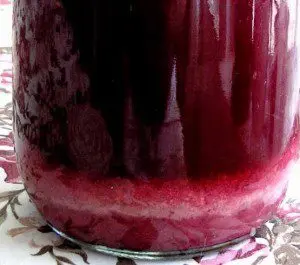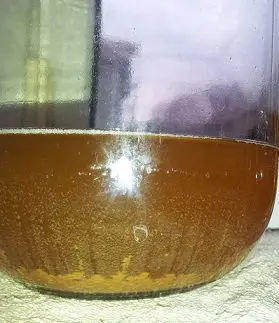Contents
Braga clarification is an optional, but very desirable stage of home brewing, which improves the quality of the finished product. But not all methods described on the Internet work well in practice. We’ll take a detailed look at the top three methods you can trust.
Why lighten the wash
Getting into the distillation cube of the moonshine still, the yeast burns. As a result, the taste and smell of moonshine deteriorate greatly. Under the influence of a sorbent (bentonite, gelatin or other additives), the yeast precipitates in an even layer or flakes, and the mash itself becomes light.
Attention! The first two methods are used only for sugar or grain mash, since the original smell of raw materials is removed along with the yeast. For the preparation of fruit distillates, I recommend using a more gentle third method.
The purification technology is in many ways similar to the clarification of wine, but there are several differences regarding the choice of sorbent, proportions, addition and time for building the mash before distillation.
Mash cleaning with bentonite
Bentonite is ideal for clarification of mash – natural white clay, which is part of cat litter (toilets). The main thing is that the filler does not contain aromatic additives that spoil the smell. Verified (at the time of this writing) brands: Pi-Pi-Bent, WC Closet Cat and Kotyara. Perhaps there are others.
Clarification with bentonite must be started when fermentation is completely over, otherwise the method will not work.
Technology
1. Grind bentonite (1 tablespoon per 10 liters of mash) in a coffee grinder.
2. Add hot water (0,5 liters per 1 tablespoon of white clay), then mix with a mixer or a spoon until a homogeneous mass is formed.
3. Pour the solution into the wash in a thin stream, mix, seal tightly and leave for 24 hours at room temperature.
4. Drain the mash from the sediment (preferably through a thin tube).
5. Overtake.

Lightening mash with hibiscus tea
Hibiscus is a tea drink made from dried Sudanese rose flowers. Due to the increased acidity, it brightens the mash no worse than bentonite.
Technology
1. Hibiscus tea flowers (70 grams per 10 liters of mash) pour 1 liter of water and bring to a boil, stirring constantly. With a different amount of mash, change the proportions.
2. Turn off the fire, cover the container with a lid and cool to 20-30°C.
3. Pour hibiscus into the mash, mix, close tightly and leave for a day (preferably at a temperature of 25-30 ° C).
4. Drain the cleaned mash from the sediment and overtake in any way possible.
After clarification, the mash will acquire a red tint. This is normal and does not affect the taste of moonshine.


Purification of fruit brews with gelatin
The method is effective specifically for fruit brews (apple, plum, pear, cherry, etc.), as it binds only the yeast sediment, leaving the taste of the raw material in the finished moonshine.
Technology
1. Pour gelatin (2 grams per 10 liters of mash) with cold water (200 ml per 1 gram of gelatin).
2. Infuse for a day at room temperature, changing the water every 8 hours.
3. Add warm water to the swollen gelatin in the proportion indicated in the 1st paragraph.
4. Pour the resulting mass into the mash.
5. After 2-3 days, drain the mash from the sediment and overtake.










